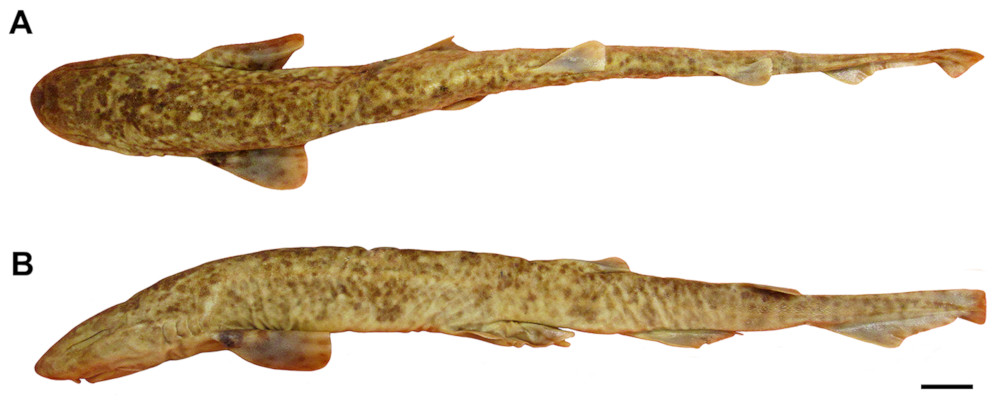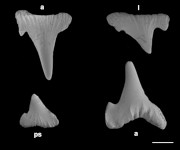Scyliorhinus duhamelii
(Garman, 1913)
Duhamel’s catshark.
Classification: Elasmobranchii Carcharhiniformes Scyliorhinidae
Reference of the original description
The Plagiostomia (Sharks, Skates and Rays). Memoirs of the Museum of Comparative Zoology at Harvard College, 36, 1–528
The Plagiostomia (Sharks, Skates and Rays). Memoirs of the Museum of Comparative Zoology at Harvard College, 36, 1–528
Image of the original description
No image in first description.
No image in first description.
Synonyms / new combinations and misspellings
Catulus duhamelii
Catulus duhamelii
Description :
Citation: Scyliorhinus duhamelii (Garman, 1913): In: Database of modern sharks, rays and chimaeras, www.shark-references.com, World Wide Web electronic publication, Version 01/2026
Please send your images of "Scyliorhinus duhamelii" to info@shark-references.com

Scyliorhinus duhamelii (Garman, 1913), Lectotype, MCZ S-63, male, 338.7 mm TL (Adriatic Sea). A, dorsal view; B, lateral view. Scale bar = 20 mm © Karla A. Soares, Laboratório de Ictiologia, Departamento de Zoologia, Instituto de Biociências, Universidade de São Paulo

Scyliorhinus duhamelii (Garman, 1913), Lectotype, MCZ S-63, male, 338.7 mm TL (Adriatic Sea). A, dorsal view; B, lateral view. Scale bar = 20 mm © Karla A. Soares, Laboratório de Ictiologia, Departamento de Zoologia, Instituto de Biociências, Universidade de São Paulo
Common names
 Duhamel’s catshark
Duhamel’s catshark
 Duhamel’s catshark
Duhamel’s catshark
Short Description
Original Diagnosis after GARMAN, 1913 [895]: Snout short, longer than the mouth, broadly rounded at the end. Nostrils nearer to the mouth than to the end of the snout. Anterior nasal valves broad, reaching the mouth, narrowly separated from one another at their median attachment; posterior valves narrow, cirroid. A labial fold on the lower jaw, extending half way to the symphysis. Upper lip closing outside of the lower at the angles. Eye medium ; lower lid closing inside the upper. Teeth very small, with three to five cusps, median longest; six rows at the symphysis of the lower jaws of much smaller teeth. Spiracle small, close to the angle of the eye. Gill openings moderate, anterior widest, hindmost smaller and above the pectoral. Dorsal fins small, first larger and originating a short distance behind the ends of the bases of the ventrals; origin of the second dorsal at the end of the base of the anal. Anal base twice the length of the base of the first dorsal, longer than its own distance from the caudal. Subcaudal short, its basal length nearly one and one half times that of the anal. Hack and fins with diffused or indefinite spots and blotches of brown varying greatly in depth of color, especially toward the back, where they are darker more or less fused and intermixed with others of white. Description from a female of 17 inches, from the Adriatic, and from a fully mature male of 131 inches, from Nice. Distinguished from Scyliorhinus caniculus by the positions of the dorsals and by the markings, and from S. stellaris by the positions of the dorsals, the markings, and a narrower separation of the nasal valves on the internarial space at the mouth. It is the smaller southern race of S. caniculus. Mediterranean Sea and Atlantic coasts of Europe.
Original Diagnosis after GARMAN, 1913 [895]: Snout short, longer than the mouth, broadly rounded at the end. Nostrils nearer to the mouth than to the end of the snout. Anterior nasal valves broad, reaching the mouth, narrowly separated from one another at their median attachment; posterior valves narrow, cirroid. A labial fold on the lower jaw, extending half way to the symphysis. Upper lip closing outside of the lower at the angles. Eye medium ; lower lid closing inside the upper. Teeth very small, with three to five cusps, median longest; six rows at the symphysis of the lower jaws of much smaller teeth. Spiracle small, close to the angle of the eye. Gill openings moderate, anterior widest, hindmost smaller and above the pectoral. Dorsal fins small, first larger and originating a short distance behind the ends of the bases of the ventrals; origin of the second dorsal at the end of the base of the anal. Anal base twice the length of the base of the first dorsal, longer than its own distance from the caudal. Subcaudal short, its basal length nearly one and one half times that of the anal. Hack and fins with diffused or indefinite spots and blotches of brown varying greatly in depth of color, especially toward the back, where they are darker more or less fused and intermixed with others of white. Description from a female of 17 inches, from the Adriatic, and from a fully mature male of 131 inches, from Nice. Distinguished from Scyliorhinus caniculus by the positions of the dorsals and by the markings, and from S. stellaris by the positions of the dorsals, the markings, and a narrower separation of the nasal valves on the internarial space at the mouth. It is the smaller southern race of S. caniculus. Mediterranean Sea and Atlantic coasts of Europe.
Distribution
Adriatic and Mediterranean Seas, along the continental shelves of Croatia, Greece, Tunisia and Argelia [27296]
Adriatic and Mediterranean Seas, along the continental shelves of Croatia, Greece, Tunisia and Argelia [27296]
Biology
Oviparous,
Oviparous,
Dentition
Monognathic heterodonty gradual well developed; anterior teeth abruptly larger than the parasymphysial ones and lateral teeth smaller distally, with smaller and thicker cusps (Fig. 42). Sexual heterodonty not observed; only adult males examined. Tooth counts 19–22 19–23/17–20 1 17–22 (20–21/20–1–18). Parasymphysial teeth with a principal cusp flanked by one cusplet on each side; cusplets 1/3 the height of the principal cusp and half of its width. Protuberances on medial portion of the crown base and striae restricted to the crown base on the labial surface. Anterior teeth similar in shape but greater than the parasymphysial ones; principal cusp three times greater than the cusplets. Anterior upper teeth with a principal cusp slightly oblique and medial portion of root with a more pronounced concavity. Protuberances and striae restricted to the crown base. Lateral teeth with three cusplets, two at the mesial edge and one at the distal edge. Mesial proximal and distal cusplets corresponding to half the height of the principal cusp and mesial marginal poorly developed; principal cusp slightly oblique on both jaws. Protuberances less prominent on crown base and striae running from the crown base until half the height of principal cusp. Commissural teeth similar to anterior ones in number of cusplets; principal cusp stouter and slightly oblique. Protuberances well prominent on the crown base and striae from the crown base until half the height of principal cusp. Ectodermal pits present in lateral and commissural teeth, restricted to the crown base [27296]
Monognathic heterodonty gradual well developed; anterior teeth abruptly larger than the parasymphysial ones and lateral teeth smaller distally, with smaller and thicker cusps (Fig. 42). Sexual heterodonty not observed; only adult males examined. Tooth counts 19–22 19–23/17–20 1 17–22 (20–21/20–1–18). Parasymphysial teeth with a principal cusp flanked by one cusplet on each side; cusplets 1/3 the height of the principal cusp and half of its width. Protuberances on medial portion of the crown base and striae restricted to the crown base on the labial surface. Anterior teeth similar in shape but greater than the parasymphysial ones; principal cusp three times greater than the cusplets. Anterior upper teeth with a principal cusp slightly oblique and medial portion of root with a more pronounced concavity. Protuberances and striae restricted to the crown base. Lateral teeth with three cusplets, two at the mesial edge and one at the distal edge. Mesial proximal and distal cusplets corresponding to half the height of the principal cusp and mesial marginal poorly developed; principal cusp slightly oblique on both jaws. Protuberances less prominent on crown base and striae running from the crown base until half the height of principal cusp. Commissural teeth similar to anterior ones in number of cusplets; principal cusp stouter and slightly oblique. Protuberances well prominent on the crown base and striae from the crown base until half the height of principal cusp. Ectodermal pits present in lateral and commissural teeth, restricted to the crown base [27296]
Remarks
shark-references Species-ID=15441;
shark-references Species-ID=15441;


















